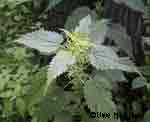Alaska Fish & Wildlife News
April 2006
Moose Research in Alaska
When Plants Fight Back

When plants are preyed upon by animals, they can't bite their attackers or run away. But they can fight back using chemical warfare.
Moose in the Nelchina Basin in Southcentral Alaska were showing signs of nutritional deficiencies, although they were surrounded by willow species that are normally considered high quality forage. When biologists Bill Collins and Don Spalinger looked at the plants the moose were eating, they discovered the willows were producing chemicals that interfered with ...
Moose Research ArticleContinued
Bird Feeders and Bears

The year-old bear in my neighbor's front yard wasn't much larger than a big Labrador retriever, but unlike a dog, the bear had a taste for bird seed.
Standing on his hind legs, he stretched up high enough to just reach the bird feeder hanging in a mountain ash tree. He couldn't pull the feeder down, but he managed to swing it hard enough to spill the black sunflower and millet seeds onto the lawn. As we watched, he licked the seeds up with his tongue and then ambled off down the street, ...
Bears ArticleContinued
The Alaska Blackfish

The Alaska blackfish looks like an overweight bulldog with fins. A severe underbite imparts a serious frown on this reclusive throwback to the dark ages. It would not be difficult to picture the little blackfish as a prime player in the evolutionary segment of Disney's Fantasia, attempting to drag itself out of the primordial soup, but not quite succeeding.
If the blackfish at one time really did attempt to exit the confines of the murky depths of our lakes, it did not fail its task completely. ...
Blackfish ArticleContinued
Outreach in Rural Alaska

The Alaska Department of Fish and Game, Division of Sport Fish staff have provided aquatic education to schools throughout rural Alaska for more than a decade. The division is now partnering with other divisions and agencies to identify high school students who are interested in the biological and social sciences, and to help them toward careers in the field of their choice. This effort is part of a much broader ongoing effort statewide on the part of Fish and Game to recruit the next generation ... Outreach ArticleContinued
Walrus Pup is Rare Rescue

Every spring the Alaska Department of Fish and Game is confronted with calls about “orphaned” baby animals. In many cases the animals are not abandoned or orphaned at all, and in most cases, even if the animal is orphaned, there is nothing the Division of Wildlife Conservation can do. In rare cases state or federal agencies may take action – such as with the Kivalina walrus.
Late last June, the Alaska State Troopers in Kotzebue received a call from the village of Kivalina that a walrus ...
Walrus Pup ArticleContinued
Building Bridges Between Arctic Peoples

Sverre Pedersen, a Subsistence Resource Specialist with the Alaska Department of Fish and Game, recently received a four-month Fulbright Scholar grant to conduct research at the Arctic Center, University of Lapland, in Rovaniemi, Finland. He arrived in Finland mid-January to study sustainable development and impact assessment methods for evaluating traditional cultures in Arctic regions where industrial development occurs.
“This exchange is all about building bridges between ...
Building Bridges ArticleContinued
Stinging Nettle Tasty Table Fare

The monthly Alaska Wildlife News recipe usually features either fish or game, but April presents an unusual opportunity. We're between most of the fishing and hunting seasons in Alaska, and spring is in the air. So this month we'll feature a side dish, a green that is at its prime in early spring – the stinging nettle.
Nettles are more than edible, they're delicious. As you can guess, they must be cooked, but it doesn't take much to neutralize the stinging. This is not one of those quasi-edible ...
Nettle ArticleContinued
